Atlas of a Lost World: Travels in Ice Age America
Air Date: Week of June 15, 2018
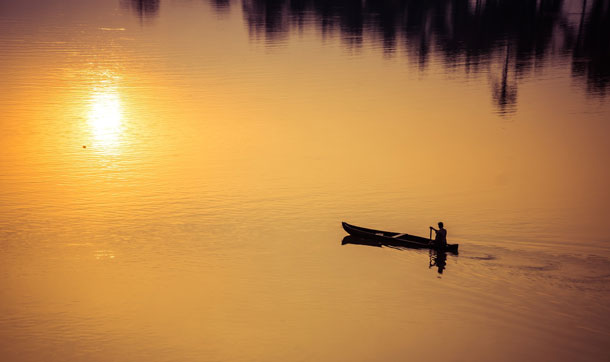
People likely traveled to the west coast of the Americas some of the way by boat – during the last Ice Age a massive ice sheet would have put a 2000 mile ice field in the way of their entry into the North American continent via the Bering land bridge. (Photo: mahfooz, Unsplash Creative Commons)
The Americas have been home to humans for at least fifteen thousand years, and people appear to have left signs they were here far earlier, too. Some apparently journeyed used boats to travel along the coast of what is now Russia and Alaska as well as possibly trekking the Bering land bridge. In his book, Atlas of a Lost World: Travels in Ice Age America, author-adventurer Craig Childs follows in their footsteps. Speaking with Host Steve Curwood, Childs tells the story of a search for understanding about the people who journeyed here long ago and reflects on how a changing climate could have spurred them to adapt.
Transcript
CURWOOD: It’s Living on Earth, I’m Steve Curwood. As the summer vacation season gets started, wanderlust is back at the fore. Some of us walk or bike, but most of us crowd onto planes, trains, ships, and automobiles to be transported to places where we can relax by the water or hike into the hillsides as we ‘get away from it all.’ And what may well be a genetic impulse to be in a new, or at least different place, may also explain why humans now occupy so much of the earth. Author Craig Childs has written “Atlas of a Lost World: Travels in Ice Age America.” Retracing the foot paths and waterways used by some of the first people to make it to the Americas, he channels the spirit of adventure they must have had.
Welcome to Living on Earth, Craig!
CHILDS: Thanks, Steve, for having me here.
CURWOOD: So, why write a book like this?
CHILDS: I think it's a blank space in a lot of people's knowledge about the Americas, what happened in the Ice Age. You might think of Clovis, you might think of mammoths, but it's a much more complicated story, and I want to take this blank space and fill it in and show this incredible moment where a side of the planet that had no people suddenly did have people. This is in a way a scientific creation story for this continent.
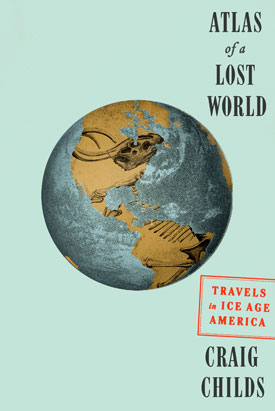
Author Craig Childs follows in the footsteps and along the paddle routes of the people who came to the west coast of the Americas thousands of years ago. (Photo: Courtesy of Craig Childs)
CURWOOD: What do you think are the most likely ways that people came here? You write extensively, of course, about the land bridge, but there were other ways as well.
CHILDS: Yeah, and the land bridge is probably the secondary route, and there were ways along the coast. Around 17,000 years ago, there was an ice mass about the size of an Antarctica sitting on half of North America. And it started retreating a little bit, which revealed a coastline so you could have gotten from the coast of the land bridge, the coast of Alaska, all the way down to Washington – by boat. On the Asian side – the Korean peninsula, Japan, Kamchatka – there was boat use going back 30,000 years to access islands you could have only gotten to from boats. So, these were probably small skin boats with wood frames, and they would have been coming down the west coast, and that's the most likely way that people in any large numbers would have gotten in. Because the land bridge, if you crossed it, it was a good place to be at the time – it was ice-free, it was a large landscape – you would run into a wall of ice on the other side, and you would have had to cross 2,000 miles of polar wasteland before touching ground again. So, I think the coast is appearing more and more as the likely way that humans got into North America.
CURWOOD: Talk to me about your quest to see what it would have been like for early people to travel along the coast via boat with a little bit of a retreat of the ice. Why did you travel the same kinds of routes that the early people in America might have undertaken?
CHILDS: I tried in as many places as possible in this book to travel in a way they would have traveled – not necessarily with skins and loincloths and spears because I think I would have died out there if I had done that [LAUGHS] – but I wanted to travel in a social way. A migration doesn't exist without kids, and so we had a group of kids going down the coast of south central Alaska, and kids ranged in age from four to 12. And so it was just the group of families. My kids were there as well, and it was interesting to navigate, to move from island to island, and send the adults ahead to check for bear presence, and having kids in big bear country is just an intense experience in general. I mean, I've traveled in Alaska quite a bit, and it's a place where it's a little wilder. It's a little bit more edgy, and it gives me a sense of maybe the ice age was a hundred times wilder. The animals are so much larger and the predators are numerous and huge, so what would it have been like to have had kids there? I travel with children frequently to remote places, and I think that this is so important because there's there's the adventure aspect going out just yourself with a couple other people who are just wild and you can just die out there and it doesn't matter. But when you're with kids, it's a whole different story. You're paying attention to things on a very different level. It's no longer about you. It is now about the adventure of your children.
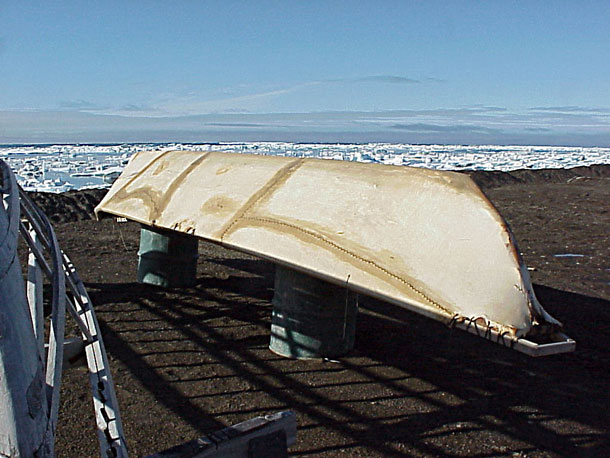
An umiaq, a type of skin-covered boat similar to what people may have used to travel along the coast of the Bering Land Bridge from Asia into North America. (Photo: Floyd Davidson, Wikimedia Commons CC BY 2.0)
CURWOOD: So, as you travel down the southeast coast of Alaska, what did you eat, and what do you think that people several thousand years ago would have eaten making that trip?
CHILDS: Well, with kids we had juice boxes. [LAUGHS] We had the 21st-century child panorama, but we also fished, we gathered clams, probably half of the food we ate was subsistence – and I think that in the ice age they were doing the same thing. They were eating whatever resource was available. There's evidence along the coast of people eating seaweed, seals, shellfish, mastodon. And there's plenty of evidence of plant use: of seeds, roots, grasses, so they weren't specialists. They certainly weren't just eating mammoths. The mammoth kills are just the most obvious because they're the largest remains, but if you get a good site with a fire and maybe the remains of a hut where you can see where people ate, you see that they were eating off the land just like you and I would if we were familiar with the place.
CURWOOD: So, science can easily document that there are humans in the Americas by, what, some 15,000 years ago, but there is some evidence that goes back much further. In fact, in your book, you hint at 130,000 years. What are these faint glimpses that we have?
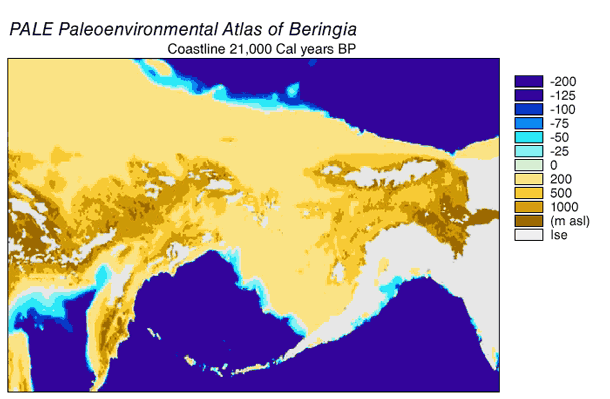
The shrinking of the Bering Land Bridge from 21,000 years before present to modern times. (Image: Courtesy of NOAA)
CHILDS: Yeah, the dates keep going back. The more closely we look, the more we see, and this 130,000-year-old find is pretty recent. It came out of San Diego and it is remains of a mastodon that looks like the bones have been shattered with a stone lifted and brought down on them and then there are rock cobbles around the bones that shouldn't naturally be there. So, it looks like an organized site that somebody took a big bone from a mastodon and smashed it and maybe got marrow out of it and left tools there. You could argue that they were trampled, but the bones looked like they were worked by humans. Since it's only one find, it's heavily debated whether this is actually human or hominid or not, but there is also evidence of bone breakage of these big animals – mastodons, bison, giant ice age bison – going back 40,000 years, so I think that we're going to keep seeing older and older dates. But there were definitely people here 15,000 years ago, likely people here 20,000 years ago. If you think about how humans migrate and the way we just go off the edge of the Earth that we look for horizon after horizon, I think it is inevitable that humans were here much earlier than we think.
CURWOOD: Craig, we need a little lesson in paleo history and ice ages. Talk to us about the periods before the massive settlements here in America and, in particular, something known as the Younger Dryas and how that might have affected things.
CHILDS: Well, ice ages are really unstable times. As we look at climate change now, we're struck by incremental changes in temperature and sea level rise because they do directly affect us and the rest of the world. But ice ages are up and down. The Younger Dryas was a cold period that struck around 12,000 years ago, and the ice age had been warming – glaciers are retreating, rivers are huge, lakes are everywhere – and then suddenly, maybe even within 10 years, the northern hemisphere plunged back into full ice age conditions. So, the glaciers started growing again; permafrost started spreading everywhere. So, it was a rapid and radical change.
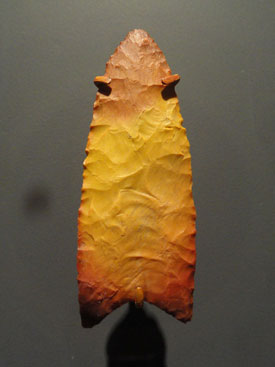
A Clovis point, c. 11,500-9000 B.C., displayed in the Natural History Museum of Utah in Salt Lake City, Utah. (Photo: Daderot, Wikimedia Commons CC 1.0)
CURWOOD: And how did that affect migration do you think?
CHILDS: I think it increased migration. It was like a pool cue hitting balls and just sending them every direction – that this was the sudden change, people had to adapt, they had to find new niches, and so it kind of divided everybody up. Whereas before the Younger Dryas, it was more of a uniform continent where they were using the same kind of weapon in Maine as they were in California. After the Younger Dryas, there were many different kinds of weapons. It was the Babylon moment where languages divided, technologies divided, and we ended up with the foundation of the continent we see today.
CURWOOD: In your book you write about the presence of a genetic marker in some people, called D4, that you say seems to be correlated with adventure and restlessness. What do we know about its presence in the first Americans?
CHILDS: Well, D4, it indicates a dopamine receptor, and people who tend to be less cautious, more risk takers, long travelers, they tend to have more D4… and I think every species has a version of this. Every species needs individuals to go out beyond the horizon and find another niche. It's how we survive, that if something goes wrong at least we know there's a backup somewhere that somebody found. And if you look at the presence of D4 in native genomes from from the Arctic to the tip of South America, you'll see that D4 increases as you go south. And to me that makes sense, that people coming in across the land bridge and down the coast would have… those with less D4 would have settled earlier. They would have gone into North America and said, this looks great. They would have landed in California and that's it.
Other people would have kept pushing and ended up in Central America. Then if you had even more, you would have kept going south into South America, which was the farthest place humans could have reached on Earth, the farthest habitable landscape. So, there is evidence that there is a genetic drive to go farther, and some people do it, and they carry those genes and they carry them all the way to the end of the Earth. I know people who have… who must have just D4… just chock full, because they don't come back. They just keep traveling and I find them somewhere else out in the world and I think, you are the real explorer. I like to come home.
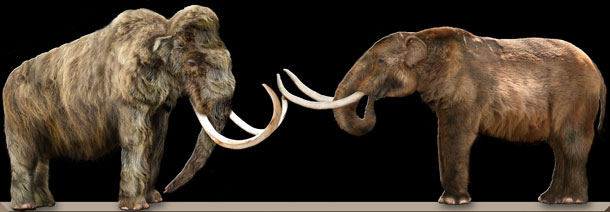
Although natural climate change played a role in the demise of the woolly mammoth (left) and the American mastodon (right), humans appear to have contributed substantially to their extinction towards the end of the last ice age. (Photo: Dantheman9758, Wikimedia Commons CC BY-SA 3.0)
CURWOOD: Stone bifaces – the tools, the weapons, of the paleo human – feature prominently in your book. You keep returning to them. These are the artifacts you described for your readers; you turn them over reverently in your hand. Why do these worked stone objects hold so much power for us do you think?
CHILDS: When you hold one of them in your hand and you're holding up a rock that somebody fashioned 15,000 years ago, you're seeing the actual hammer blows of their strikes. The actual object takes you back to that moment: you can hear the sound of stone on stone, of their work. And I went down into a trench, at a dig in Texas where they're coming across human artifacts 15,500 ago, and I picked one up from the very bottom of the dig. It was still sharp enough that you could have cut flesh with it, and you're holding this thing that somebody else touched. The last person to touch it was that person during the Ice Age where they were mammoths around this flint napper, and so you're transported back. You feel time in a very different way. It's making contact with a time that we don't have. I mean, most of our lives we're touching things that were just made a month ago or a year ago where everything is getting newer and newer, and I want to remember what it was like. I want us to have a context of how long humans have been doing this and touching this object is a way of making direct contact with those people.
CURWOOD: Holding these objects, what kind of feelings come up from yourself and for the people that might have made them?
CHILDS: Well, it's an interesting feeling because in one sense I feel like going, yeah, humans, I know you, you're like me, we're the adventurous species, we’re the pioneers, we will do anything. And then there is this kind of dread of, oh my God, we're humans, we're these pioneers, we're making weapons and this is what we do. We spread as far as we can. So, I have this very mixed relationship with our species that's a bigger relationship than just being here now. It's a relationship with us going back tens of thousands of years, and in one sense I feel like a cheerleader for the species that I'm so proud and impressed with what we do but, in the other sense, I'm horrified by what we do because I think, is there no end to this? Are we just taking down every animal we can? Are we just building weapons upon weapons? So, I have a very mixed reaction when I meet these ancient people through their artifacts.
CURWOOD: Craig, before you go, what kind of message do you see in the way people have adapted to climatic change in the past for our current predicament as we face rapid climate disruption?
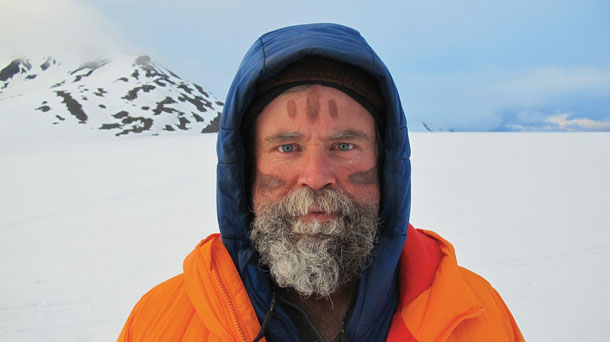
Craig Childs is the author of Atlas of a Lost World and seven other books. (Photo: Sarah Gilman ©)
CHILDS: Well, people adapted. They figured out how to get around the collapse of the Ice Age and something that I saw in their adaptation was that they, at the last moment when climate was really erupting around 13,000 years ago and you were having massive floods and sea level rise, people started making giant weapons and started killing the largest animals around and that – the world was coming apart, so they made themselves huge. And in doing so, they killed off the last remaining large megafauna. And I'm looking at us now thinking, oh, we're doing the same thing.
We're making massive weapons. We're making ourselves huge. And I'm not convinced that we have changed that much since 13,000 years ago. I think we are very much still the same people, but I am hoping that we've got a better grasp on the world we live in so that maybe we don't have to make ourselves so huge, that in the Ice Age they eventually stopped making giant weapons. Their weapons became smaller and smaller to adapt to changing climate and changing animals. I think that we could do the same, but maybe we can get a jump on it. Maybe we can change before the change happens.
CURWOOD: Craig Childs is the author of “Atlas of a Lost World: Travels in Ice Age America.” Craig, thanks so much for taking the time with us today.
CHILDS: Thank you for having me, Steve.
Links
Living on Earth wants to hear from you!
Living on Earth
62 Calef Highway, Suite 212
Lee, NH 03861
Telephone: 617-287-4121
E-mail: comments@loe.org
Newsletter [Click here]
Donate to Living on Earth!
Living on Earth is an independent media program and relies entirely on contributions from listeners and institutions supporting public service. Please donate now to preserve an independent environmental voice.
NewsletterLiving on Earth offers a weekly delivery of the show's rundown to your mailbox. Sign up for our newsletter today!
 Sailors For The Sea: Be the change you want to sea.
Sailors For The Sea: Be the change you want to sea.
 The Grantham Foundation for the Protection of the Environment: Committed to protecting and improving the health of the global environment.
The Grantham Foundation for the Protection of the Environment: Committed to protecting and improving the health of the global environment.
 Contribute to Living on Earth and receive, as our gift to you, an archival print of one of Mark Seth Lender's extraordinary wildlife photographs. Follow the link to see Mark's current collection of photographs.
Contribute to Living on Earth and receive, as our gift to you, an archival print of one of Mark Seth Lender's extraordinary wildlife photographs. Follow the link to see Mark's current collection of photographs.
 Buy a signed copy of Mark Seth Lender's book Smeagull the Seagull & support Living on Earth
Buy a signed copy of Mark Seth Lender's book Smeagull the Seagull & support Living on Earth

